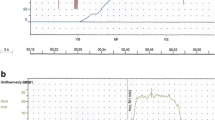Abstract
Primary bladder neck dysfunction is a non-neurogenic voiding disorder commonly diagnosed in young and middle age adult men, but frequently overlooked in children. Because these children typically present with lower urinary tract symptoms that also are associated with other more common forms of dysfunctional voiding, the diagnosis may be missed and treated with a variety of empiric modalities that ultimately fail. Although its underlying pathogenesis remains debated, the hallmark of the diagnosis is a failure of the bladder neck to properly open and allow for unimpeded urine flow. Videourodynamic evaluation is the only diagnostic tool that can urodynamically document the obstructive pressure/flow parameters of the condition while simultaneously localizing the functional obstruction to the bladder neck fluoroscopically. This article reviews the clinical and urodynamic findings of this entity in children and adolescents and our experience with α adrenergic antagonists, the current approach in medical therapy.
Similar content being viewed by others
References and Recommended Reading
Hinman F, Baumann FW: Vesical and ureteral damage from voiding dysfunction in boys without neurologic or obstructive disease. J Urol 1973, 109:727.
Combs AJ, Horowitz M, Glassberg KI: Primary bladder neck dysfunction and dysfunctional voiding in children: similar clinical presentation, different, clinical and urodynamic consequences. Paper presented at the Annual Meeting of the American Academy of Pediatrics. San Francisco: October 20–22, 2001.
Combs AJ, Glassberg AD, Gerdes D, Horowitz M: Biofeedback therapy for children with dysfunctional voiding. Urology 1998, 52:312–315.
Kaplan SA, Ikeguchi EF, Santarosa RP, et al.: Etiology of voiding dysfunction in men less than 50 years of age. Urology 1996, 47:836–839. This is an important study that demonstrates the high prevalence of PBND among young adult and middle-aged men with chronic lower urinary tract symptoms. As in children, these patients often are treated for long periods of time with various misdirected therapies. The use of urodynamics in diagnosing PBND in adults and targeting therapy is demonstrated.
Nitti VW, Lefkowitz G, Ficazzola M, Dixon CM: Lower urinary tract symptoms in young men: videourodynamic findings and correlation with noninvasive measures. J Urol 2002, 168:135–138. PBND was the most common urodynamic diagnosis in a group of men between the ages of 18 and 45 years with lower urinary tract symptoms of non-neurogenic origin. The authors introduce the concept of using noninvasive uroflow to screen for patients who would benefit from proceeding to formal VUDS.
Norlen LJ, Blaivas JG: Unsuspected proximal urethral obstruction in young and middle-aged men. J Urol 1986, 135:972–976.
Nitti VW, Tu LM, Gitlin J: Diagnosing bladder outlet obstruction in women. J Urol 1999, 161:1535–1540.
Norgaard JP, Schwartz-Sorensen S, Djurhuus JC: Functional bladder outlet obstruction in women. Urol Int 1984, 39:207–210.
Smey P, King LR, Firlit CF: Dysfunctional voiding in children secondary to internal sphincter dyssynergia: treatment with phenoxybenzamine. Urol Clin North Am 1980, 7:337–347.
Koff SA, Wagner TT, Jayanthi VR: The relationship among dysfunctional elimination syndromes, primary vesicoureteral reflux, and urinary tract infections in children. J Urol 1998, 160:1019–1022.
Poulsen EU, Kirkeby HJ, Djurhuus JC: Urodynamic effect of acute <.receptor blockade in patients with bladder neck dysfunction. Scand J Urol Nephrol 1989, 23:15–20.
Manoliu RA: Voiding cystourethrography with synchronous measurements of pressures and flow in the diagnosis of subvesical obstruction in men: a radiological view. J Urol 1987, 137:1196–1201.
Poulsen EU, Kirkeby HJ: Symptomatology and urodynamic findings in younger males with bladder neck dysfunction. Scand J Urol Nephrol Suppl 1989, 125:59–63.
Combs AJ, Grafstein NH, Glassberg KI: The EMG lag time: a new noninvasive method to accurately screen for and monitor therapeutic response in children and adolescents with primary bladder neck dysfunction. Paper presented at the Annual Meeting of the American Academy of Pediatrics. New Orleans: October 31–November 5, 2003.
Donohoe JM, Combs AJ, Misseri R, Glassberg KI: Primary bladder neck dysfunction in children: results of treatment with alpha-adrenergic antagonists. Paper presented at the Annual Meeting of the American Academy of Pediatrics. Boston: October 19–23, 2002.
Crowe R, Noble J, Robson T, et al.: An increase of neuropeptide Y but not nitric oxide synthase-immunoreactive nerves in the bladder neck from male patients with bladder neck dyssynergia. J Urol 1995, 154:1231–1236.
Awad SA, Downie JW, Lywood DW, et al.: Sympathetic activity in the proximal urethra in patients with urinary obstruction. J Urol 1976, 115:545–547.
Bates CP, Arnold EP, Griffiths DJ: The nature of the abnormality in bladder neck obstruction. Br J Urol 1975, 47:651–655.
Yalla SV, Resnick NM: Initiation of voiding in humans: the nature and temporal relationship of urethral sphincter responses. J Urol 1997, 157:590–595.
Abrams P, Cardozo L, Fall M, et al.: The standardization of terminology in lower urinary tract function: report from the standardization sub-committee of the International Continence Society. Urology 2003, 61:37–49.
Turner-Warwick R, Whiteside CG, Worth PH, et al.: A urodynamic view of the clinical problems associated with bladder neck dysfunction and its treatment by endoscopic incision and transtrigonal posterior prostatectomy. Br J Urol 1973, 45:44–49.
Bauer SB, Koff SA, Jayanthi VR: Voiding dysfunction in children: neurogenic and non-neurogenic. In Campbell’s Urology. Edited by Walsh PC, Retik AB, Vaughan ED Jr, Wein AJ. Philadelphia: WB Saunders; 2002:2231–2283.
Kaplan SA, Te AE, Jacobs BZ: Urodynamic evidence of vesical neck obstruction in men with misdiagnosed chronic nonbacterial prostatitis and the therapeutic role of endoscopic incision of the bladder neck. J Urol 1994, 152:2063–2065.
Trockman BA, Gerspach J, Dmochowski R, et al.: Primary bladder neck obstruction: urodynamic findings and treatment results in 36 men. J Urol 1996, 156:1418–1420.
Austin PF, Homsy YL, Casale AJ, et al.: alpha-Adrenergic blockade in children with neuropathic and non-neuropathic voiding dysfunction. J Urol 1999, 162:1064–1067. This article demonstrates the efficacy and safety of using selective α1-antagonists in children. Doxazosin improved bladder emptying in children with various disorders featuring bladder outlet obstruction without significant adverse effects.
Author information
Authors and Affiliations
Rights and permissions
About this article
Cite this article
Grafstein, N.H., Combs, A.J. & Glassberg, K.I. Primary bladder neck dysfunction: An overlooked entity in children. Curr Urol Rep 6, 133–139 (2005). https://doi.org/10.1007/s11934-005-0082-6
Issue Date:
DOI: https://doi.org/10.1007/s11934-005-0082-6




